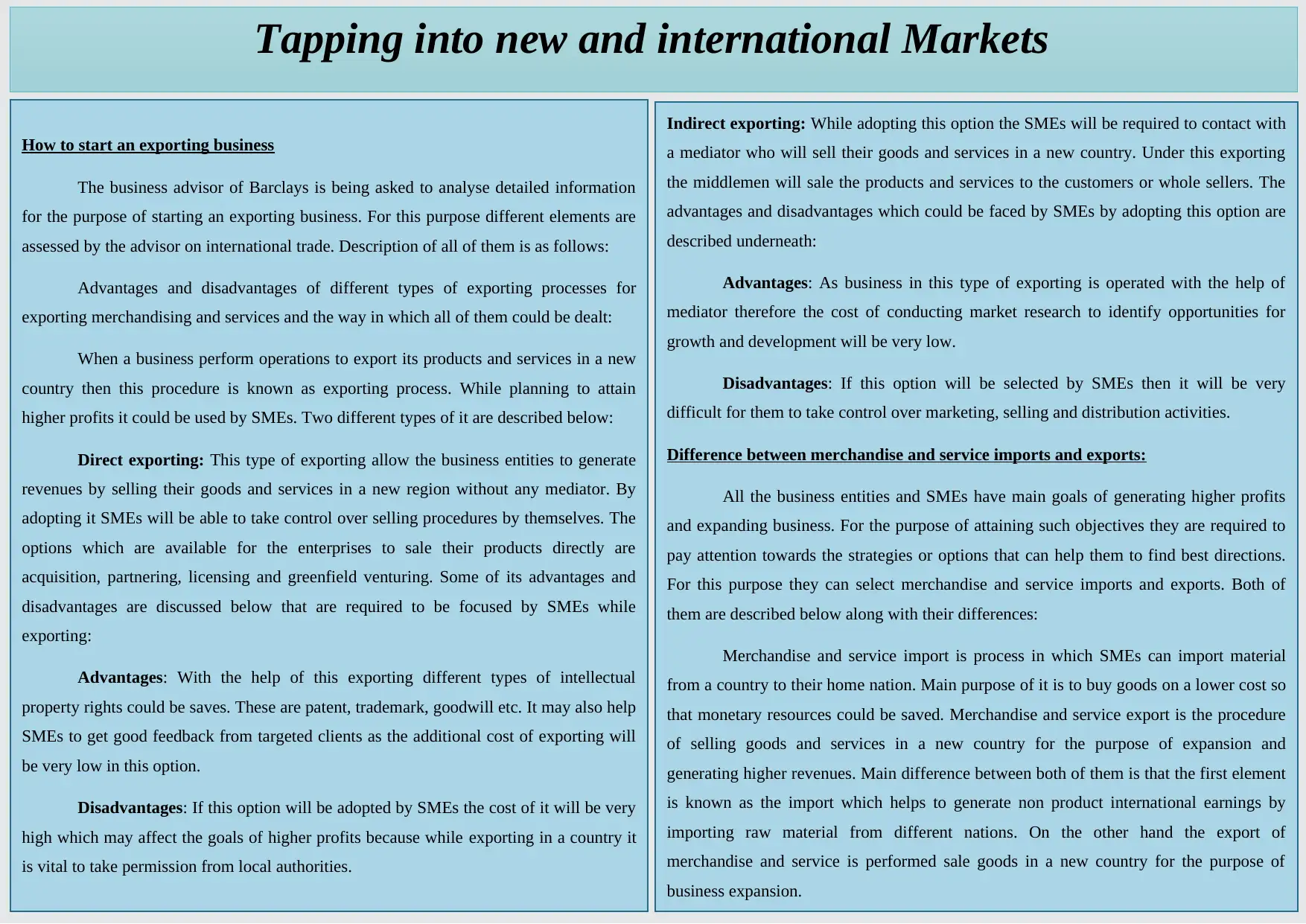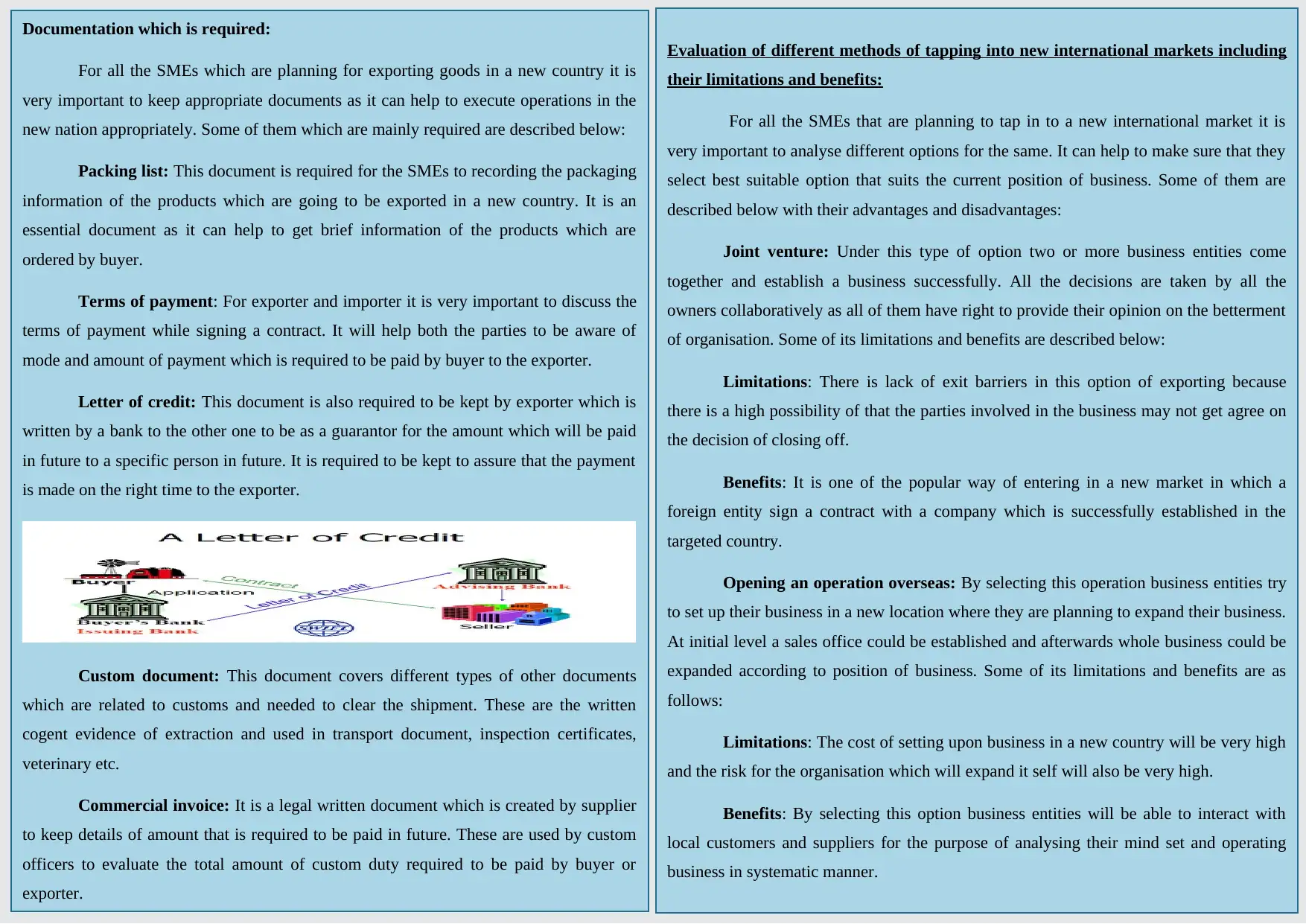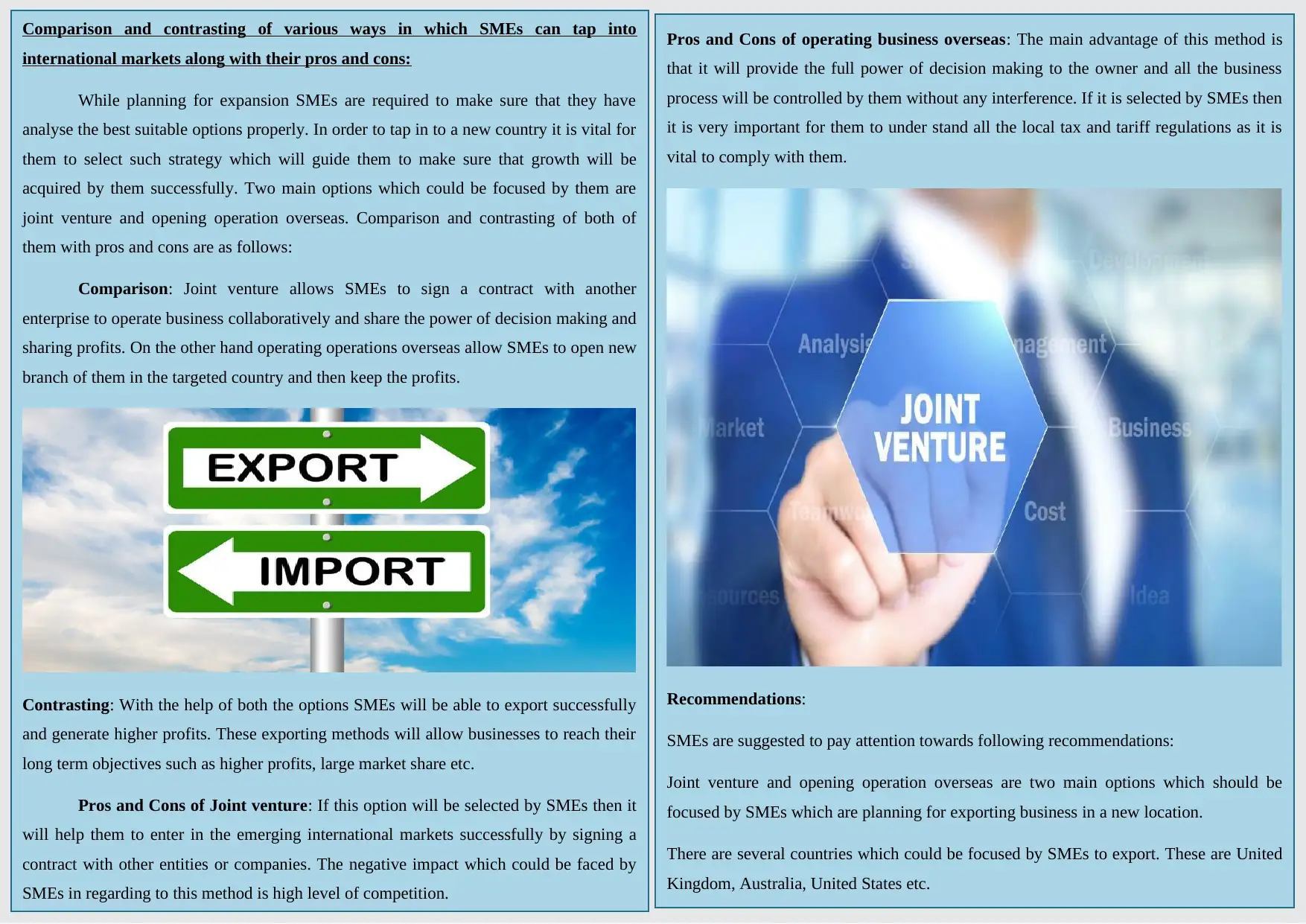Exporting Business: Strategies for Tapping International Markets
VerifiedAdded on 2023/01/13
|4
|1682
|46
Report
AI Summary
This report analyzes various strategies for SMEs to enter international markets, focusing on direct and indirect exporting methods. It details the advantages and disadvantages of each approach, including factors like intellectual property protection, market research costs, and control over marketing. The report differentiates between merchandise and service imports/exports, emphasizing the importance of documentation like packing lists, terms of payment, and letters of credit. It evaluates different market entry methods such as joint ventures and opening overseas operations, comparing their limitations and benefits. The analysis includes the pros and cons of joint ventures and overseas operations, offering recommendations for SMEs aiming to expand globally. The report also provides a comparison and contrast of these methods, aiding businesses in making informed decisions to achieve higher profits and a larger market share.

Indirect exporting: While adopting this option the SMEs will be required to contact with
a mediator who will sell their goods and services in a new country. Under this exporting
the middlemen will sale the products and services to the customers or whole sellers. The
advantages and disadvantages which could be faced by SMEs by adopting this option are
described underneath:
Advantages: As business in this type of exporting is operated with the help of
mediator therefore the cost of conducting market research to identify opportunities for
growth and development will be very low.
Disadvantages: If this option will be selected by SMEs then it will be very
difficult for them to take control over marketing, selling and distribution activities.
Difference between merchandise and service imports and exports:
All the business entities and SMEs have main goals of generating higher profits
and expanding business. For the purpose of attaining such objectives they are required to
pay attention towards the strategies or options that can help them to find best directions.
For this purpose they can select merchandise and service imports and exports. Both of
them are described below along with their differences:
Merchandise and service import is process in which SMEs can import material
from a country to their home nation. Main purpose of it is to buy goods on a lower cost so
that monetary resources could be saved. Merchandise and service export is the procedure
of selling goods and services in a new country for the purpose of expansion and
generating higher revenues. Main difference between both of them is that the first element
is known as the import which helps to generate non product international earnings by
importing raw material from different nations. On the other hand the export of
merchandise and service is performed sale goods in a new country for the purpose of
business expansion.
How to start an exporting business
The business advisor of Barclays is being asked to analyse detailed information
for the purpose of starting an exporting business. For this purpose different elements are
assessed by the advisor on international trade. Description of all of them is as follows:
Advantages and disadvantages of different types of exporting processes for
exporting merchandising and services and the way in which all of them could be dealt:
When a business perform operations to export its products and services in a new
country then this procedure is known as exporting process. While planning to attain
higher profits it could be used by SMEs. Two different types of it are described below:
Direct exporting: This type of exporting allow the business entities to generate
revenues by selling their goods and services in a new region without any mediator. By
adopting it SMEs will be able to take control over selling procedures by themselves. The
options which are available for the enterprises to sale their products directly are
acquisition, partnering, licensing and greenfield venturing. Some of its advantages and
disadvantages are discussed below that are required to be focused by SMEs while
exporting:
Advantages: With the help of this exporting different types of intellectual
property rights could be saves. These are patent, trademark, goodwill etc. It may also help
SMEs to get good feedback from targeted clients as the additional cost of exporting will
be very low in this option.
Disadvantages: If this option will be adopted by SMEs the cost of it will be very
high which may affect the goals of higher profits because while exporting in a country it
is vital to take permission from local authorities.
Tapping into new and international Markets
a mediator who will sell their goods and services in a new country. Under this exporting
the middlemen will sale the products and services to the customers or whole sellers. The
advantages and disadvantages which could be faced by SMEs by adopting this option are
described underneath:
Advantages: As business in this type of exporting is operated with the help of
mediator therefore the cost of conducting market research to identify opportunities for
growth and development will be very low.
Disadvantages: If this option will be selected by SMEs then it will be very
difficult for them to take control over marketing, selling and distribution activities.
Difference between merchandise and service imports and exports:
All the business entities and SMEs have main goals of generating higher profits
and expanding business. For the purpose of attaining such objectives they are required to
pay attention towards the strategies or options that can help them to find best directions.
For this purpose they can select merchandise and service imports and exports. Both of
them are described below along with their differences:
Merchandise and service import is process in which SMEs can import material
from a country to their home nation. Main purpose of it is to buy goods on a lower cost so
that monetary resources could be saved. Merchandise and service export is the procedure
of selling goods and services in a new country for the purpose of expansion and
generating higher revenues. Main difference between both of them is that the first element
is known as the import which helps to generate non product international earnings by
importing raw material from different nations. On the other hand the export of
merchandise and service is performed sale goods in a new country for the purpose of
business expansion.
How to start an exporting business
The business advisor of Barclays is being asked to analyse detailed information
for the purpose of starting an exporting business. For this purpose different elements are
assessed by the advisor on international trade. Description of all of them is as follows:
Advantages and disadvantages of different types of exporting processes for
exporting merchandising and services and the way in which all of them could be dealt:
When a business perform operations to export its products and services in a new
country then this procedure is known as exporting process. While planning to attain
higher profits it could be used by SMEs. Two different types of it are described below:
Direct exporting: This type of exporting allow the business entities to generate
revenues by selling their goods and services in a new region without any mediator. By
adopting it SMEs will be able to take control over selling procedures by themselves. The
options which are available for the enterprises to sale their products directly are
acquisition, partnering, licensing and greenfield venturing. Some of its advantages and
disadvantages are discussed below that are required to be focused by SMEs while
exporting:
Advantages: With the help of this exporting different types of intellectual
property rights could be saves. These are patent, trademark, goodwill etc. It may also help
SMEs to get good feedback from targeted clients as the additional cost of exporting will
be very low in this option.
Disadvantages: If this option will be adopted by SMEs the cost of it will be very
high which may affect the goals of higher profits because while exporting in a country it
is vital to take permission from local authorities.
Tapping into new and international Markets
Paraphrase This Document
Need a fresh take? Get an instant paraphrase of this document with our AI Paraphraser

Evaluation of different methods of tapping into new international markets including
their limitations and benefits:
For all the SMEs that are planning to tap in to a new international market it is
very important to analyse different options for the same. It can help to make sure that they
select best suitable option that suits the current position of business. Some of them are
described below with their advantages and disadvantages:
Joint venture: Under this type of option two or more business entities come
together and establish a business successfully. All the decisions are taken by all the
owners collaboratively as all of them have right to provide their opinion on the betterment
of organisation. Some of its limitations and benefits are described below:
Limitations: There is lack of exit barriers in this option of exporting because
there is a high possibility of that the parties involved in the business may not get agree on
the decision of closing off.
Benefits: It is one of the popular way of entering in a new market in which a
foreign entity sign a contract with a company which is successfully established in the
targeted country.
Opening an operation overseas: By selecting this operation business entities try
to set up their business in a new location where they are planning to expand their business.
At initial level a sales office could be established and afterwards whole business could be
expanded according to position of business. Some of its limitations and benefits are as
follows:
Limitations: The cost of setting upon business in a new country will be very high
and the risk for the organisation which will expand it self will also be very high.
Benefits: By selecting this option business entities will be able to interact with
local customers and suppliers for the purpose of analysing their mind set and operating
business in systematic manner.
Documentation which is required:
For all the SMEs which are planning for exporting goods in a new country it is
very important to keep appropriate documents as it can help to execute operations in the
new nation appropriately. Some of them which are mainly required are described below:
Packing list: This document is required for the SMEs to recording the packaging
information of the products which are going to be exported in a new country. It is an
essential document as it can help to get brief information of the products which are
ordered by buyer.
Terms of payment: For exporter and importer it is very important to discuss the
terms of payment while signing a contract. It will help both the parties to be aware of
mode and amount of payment which is required to be paid by buyer to the exporter.
Letter of credit: This document is also required to be kept by exporter which is
written by a bank to the other one to be as a guarantor for the amount which will be paid
in future to a specific person in future. It is required to be kept to assure that the payment
is made on the right time to the exporter.
Custom document: This document covers different types of other documents
which are related to customs and needed to clear the shipment. These are the written
cogent evidence of extraction and used in transport document, inspection certificates,
veterinary etc.
Commercial invoice: It is a legal written document which is created by supplier
to keep details of amount that is required to be paid in future. These are used by custom
officers to evaluate the total amount of custom duty required to be paid by buyer or
exporter.
their limitations and benefits:
For all the SMEs that are planning to tap in to a new international market it is
very important to analyse different options for the same. It can help to make sure that they
select best suitable option that suits the current position of business. Some of them are
described below with their advantages and disadvantages:
Joint venture: Under this type of option two or more business entities come
together and establish a business successfully. All the decisions are taken by all the
owners collaboratively as all of them have right to provide their opinion on the betterment
of organisation. Some of its limitations and benefits are described below:
Limitations: There is lack of exit barriers in this option of exporting because
there is a high possibility of that the parties involved in the business may not get agree on
the decision of closing off.
Benefits: It is one of the popular way of entering in a new market in which a
foreign entity sign a contract with a company which is successfully established in the
targeted country.
Opening an operation overseas: By selecting this operation business entities try
to set up their business in a new location where they are planning to expand their business.
At initial level a sales office could be established and afterwards whole business could be
expanded according to position of business. Some of its limitations and benefits are as
follows:
Limitations: The cost of setting upon business in a new country will be very high
and the risk for the organisation which will expand it self will also be very high.
Benefits: By selecting this option business entities will be able to interact with
local customers and suppliers for the purpose of analysing their mind set and operating
business in systematic manner.
Documentation which is required:
For all the SMEs which are planning for exporting goods in a new country it is
very important to keep appropriate documents as it can help to execute operations in the
new nation appropriately. Some of them which are mainly required are described below:
Packing list: This document is required for the SMEs to recording the packaging
information of the products which are going to be exported in a new country. It is an
essential document as it can help to get brief information of the products which are
ordered by buyer.
Terms of payment: For exporter and importer it is very important to discuss the
terms of payment while signing a contract. It will help both the parties to be aware of
mode and amount of payment which is required to be paid by buyer to the exporter.
Letter of credit: This document is also required to be kept by exporter which is
written by a bank to the other one to be as a guarantor for the amount which will be paid
in future to a specific person in future. It is required to be kept to assure that the payment
is made on the right time to the exporter.
Custom document: This document covers different types of other documents
which are related to customs and needed to clear the shipment. These are the written
cogent evidence of extraction and used in transport document, inspection certificates,
veterinary etc.
Commercial invoice: It is a legal written document which is created by supplier
to keep details of amount that is required to be paid in future. These are used by custom
officers to evaluate the total amount of custom duty required to be paid by buyer or
exporter.

⊘ This is a preview!⊘
Do you want full access?
Subscribe today to unlock all pages.

Trusted by 1+ million students worldwide

Pros and Cons of operating business overseas: The main advantage of this method is
that it will provide the full power of decision making to the owner and all the business
process will be controlled by them without any interference. If it is selected by SMEs then
it is very important for them to under stand all the local tax and tariff regulations as it is
vital to comply with them.
Recommendations:
SMEs are suggested to pay attention towards following recommendations:
Joint venture and opening operation overseas are two main options which should be
focused by SMEs which are planning for exporting business in a new location.
There are several countries which could be focused by SMEs to export. These are United
Kingdom, Australia, United States etc.
Comparison and contrasting of various ways in which SMEs can tap into
international markets along with their pros and cons:
While planning for expansion SMEs are required to make sure that they have
analyse the best suitable options properly. In order to tap in to a new country it is vital for
them to select such strategy which will guide them to make sure that growth will be
acquired by them successfully. Two main options which could be focused by them are
joint venture and opening operation overseas. Comparison and contrasting of both of
them with pros and cons are as follows:
Comparison: Joint venture allows SMEs to sign a contract with another
enterprise to operate business collaboratively and share the power of decision making and
sharing profits. On the other hand operating operations overseas allow SMEs to open new
branch of them in the targeted country and then keep the profits.
Contrasting: With the help of both the options SMEs will be able to export successfully
and generate higher profits. These exporting methods will allow businesses to reach their
long term objectives such as higher profits, large market share etc.
Pros and Cons of Joint venture: If this option will be selected by SMEs then it
will help them to enter in the emerging international markets successfully by signing a
contract with other entities or companies. The negative impact which could be faced by
SMEs in regarding to this method is high level of competition.
that it will provide the full power of decision making to the owner and all the business
process will be controlled by them without any interference. If it is selected by SMEs then
it is very important for them to under stand all the local tax and tariff regulations as it is
vital to comply with them.
Recommendations:
SMEs are suggested to pay attention towards following recommendations:
Joint venture and opening operation overseas are two main options which should be
focused by SMEs which are planning for exporting business in a new location.
There are several countries which could be focused by SMEs to export. These are United
Kingdom, Australia, United States etc.
Comparison and contrasting of various ways in which SMEs can tap into
international markets along with their pros and cons:
While planning for expansion SMEs are required to make sure that they have
analyse the best suitable options properly. In order to tap in to a new country it is vital for
them to select such strategy which will guide them to make sure that growth will be
acquired by them successfully. Two main options which could be focused by them are
joint venture and opening operation overseas. Comparison and contrasting of both of
them with pros and cons are as follows:
Comparison: Joint venture allows SMEs to sign a contract with another
enterprise to operate business collaboratively and share the power of decision making and
sharing profits. On the other hand operating operations overseas allow SMEs to open new
branch of them in the targeted country and then keep the profits.
Contrasting: With the help of both the options SMEs will be able to export successfully
and generate higher profits. These exporting methods will allow businesses to reach their
long term objectives such as higher profits, large market share etc.
Pros and Cons of Joint venture: If this option will be selected by SMEs then it
will help them to enter in the emerging international markets successfully by signing a
contract with other entities or companies. The negative impact which could be faced by
SMEs in regarding to this method is high level of competition.
1 out of 4
Related Documents
Your All-in-One AI-Powered Toolkit for Academic Success.
+13062052269
info@desklib.com
Available 24*7 on WhatsApp / Email
![[object Object]](/_next/static/media/star-bottom.7253800d.svg)
Unlock your academic potential
Copyright © 2020–2025 A2Z Services. All Rights Reserved. Developed and managed by ZUCOL.




